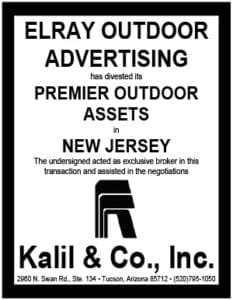 Washington, DC (January 8, 2018) – The development and implementation of smart cities will create opportunity for the out of home (OOH) advertising industry, according to a new study released by the Outdoor Advertising Association of America (OAAA). Connected technologies matter most for OOH as the future of smart cities evolves.
Washington, DC (January 8, 2018) – The development and implementation of smart cities will create opportunity for the out of home (OOH) advertising industry, according to a new study released by the Outdoor Advertising Association of America (OAAA). Connected technologies matter most for OOH as the future of smart cities evolves.
“The smart cities phenomenon is creating real opportunities for the OOH industry,” according to the report, prepared by Gordon Feller, Meeting of the Minds, a group that brings together urban sustainability and technology leaders. “As cities embrace for big changes wrought by the digital wave, city leaders are making investments in ‘commonplace’ physical assets: streetlights, traffic lights, parking meters, bus stops, and more. A consequence of becoming smarter creates business opportunities for the OOH industry.”
“This report fills a big gap in our industry’s existing knowledge about OOH’s role in smart cities,” said OAAA’s Chief Marketing Officer Stephen Freitas. “These insights point the way to new opportunities, which key companies will be anxious to pursue this year and beyond.”
For OOH media companies, the vital connections that matter can be divided into three types:
- Machine-to-Machine (M2M) Connections: Information transferred from include sensors, robots, computers, and mobile devices. Often called the Internet of Things (IoT).
- Machine-to-People (M2P) Connections: Information transferred from a machine to a person, or vice versa. Referred to as Data & Analytics.
- People-to-People (P2P) Connections: Information transferred from one person to another. Increasingly, P2P connections happen virtually, through video, mobile devices, and social networks.
 The report urges the OOH industry to explore how it can participate in the transformation from conventional to smart cities. A starting point is to think about how the industry integrates with the four core elements of smart cities: people, process, data, and things.
The report urges the OOH industry to explore how it can participate in the transformation from conventional to smart cities. A starting point is to think about how the industry integrates with the four core elements of smart cities: people, process, data, and things.
- People: OOH connects people in more relevant, valuable ways.
- Process: OOH delivers the right information to the right people at the right time.
- Data: OOH leverages data to better target audiences.
- Things: Connected devices and objects (smart sensors) can be attached to OOH structures.
“Cities want to become smarter in ways that make themselves a more attractive place to live and work,” according to the report. “To achieve this goal, city planners and leaders are looking for partners to provide valuable expertise or knowledge.”
The report offers questions and answers to help the OOH industry understand opportunities associated with data, services, and security, building a foundation on which to keep pace with the smart cities phenomenon. Addressed in the report are topics such as ideal smart city characteristics, data-privacy concerns, potential revenue streams, and common steps municipalities are taking to build smart city infrastructures.
“Smart city assets that include public kiosks and traditional OOH assets provide cities with an infrastructure that offers compelling applications for city functions,” according to the report. “The aim of each smart city initiative is to connect people to mission-critical information, which in turn helps enhance the quality of city living.”
The full report is available at oaaa.org or by calling OAAA at (202) 833-5566.
Members of the press should contact Nicole Randall (nradnall@oaaa.org) for a copy of the report.
OAAA is the national trade association for the out of home (OOH) advertising industry. Founded in 1891, the association represents more than 90 percent of the US industry based on revenues. OAAA is dedicated to leading and uniting a responsible OOH industry committed to serving advertisers, consumers, and communities. The OOH industry generates $7.6 billion annually in ad revenues and donates more than $500 million in space each year to public service efforts. For more information, please visit www.oaaa.org.
[wpforms id=”9787″]
Paid Advertisement

















